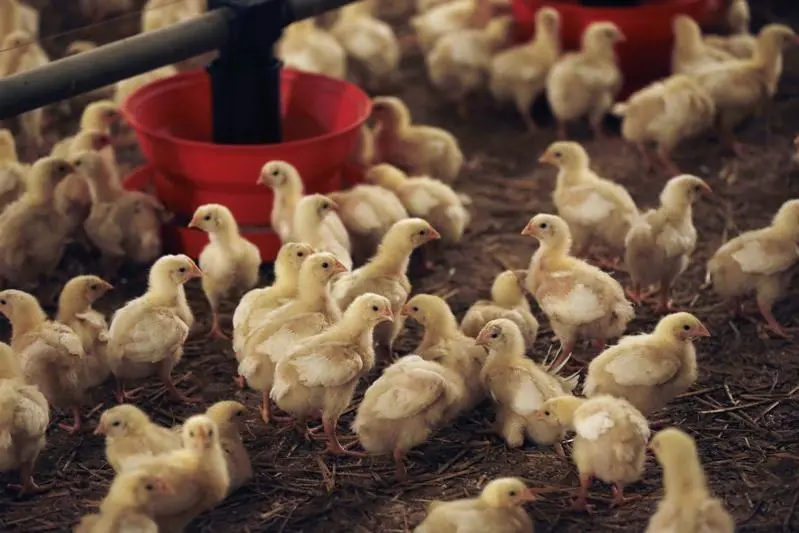PHOTO
A near-record number of U.S. chickens and turkeys have died in this year's outbreak of avian flu, as a different form of the virus than farmers battled before has infected more wild birds that then transmit the disease, officials said.
More than 47 million birds have died due to infections and cullings. This has spurred export bans, lowered egg and turkey production, and contributed to record prices of the staples ahead of the U.S. holiday season. The outbreak exacerbates economic pain for consumers grappling with soaring inflation.
In 2015, 50.5 million birds died in the deadliest U.S. outbreak, the nation's worst animal-health event to date.
Farmers are fighting a subtype of the H5N1 strain of the virus that survived over the summer, when rising temperatures typically reduce avian flu, said Rosemary Sifford, chief veterinary officer for the U.S. Department of Agriculture (USDA).
The same subtype, known as the goose/Guangdong lineage, is spreading in Europe, she said in an interview. Europe is already suffering its worst avian flu crisis, with nearly 50 million poultry culled.
Officials are finding the subtype in a broader range of wild birds, such as ducks, than in the past and it seems to live in the birds longer, Sifford said. An elevated threat for infections may persist until summer 2023 as they migrate, she said.
The United States is monitoring wild birds for avian flu in four migration paths known as flyways, up from two previously, and plans to do the same next year.
"This virus could be present in wild birds for the foreseeable future," Sifford said. "This one is certainly different."
The outbreak has infected flocks in 42 states since February, twice as many as in 2015, USDA records show. Infections slowed over the summer this year but did not stop as they did in 2015.
The tenacity of the virus surprised some producers, who have boosted cleaning and security in barns since the 2015 outbreak.
"Unfortunately what we've done probably hasn't been enough to protect us from this high load of virus in the wild bird population," Sifford said.
RECORD TURKEY PRICES
Minnesota, the nation's top turkey-producing state, suffered infections in two commercial flocks in late August after going three months without cases, USDA data show. The state then saw more cases in September.
"Seeing a spike in August was not something that was expected," said Ashley Kohls, executive director of the Minnesota Turkey Growers Association.
After infections, it takes about six months to decontaminate farms and resume turkey production, Kohls said.
Minnesota-based Hormel Foods Corp, owner of the Jennie-O Turkey Store brand, said it expects avian flu to reduce its turkey production at least through March 2023.
"We've worked really hard but clearly this is still an issue," Hormel CEO James Snee said on a conference call last month.
Retail prices for fresh boneless, skinless turkey breast reached a record $6.70 per pound last month, up 112% from a year earlier and 14% above the previous record from 2015, the American Farm Bureau said.
Turkey meat production this year is set to drop 6% from 2021 to 5.2 billion pounds, according to the USDA.
U.S. farmers, who face high costs for feed and labor, were already cutting production before the outbreak due to declining profits. Inventories of turkey breasts in cold storage facilities reached a record low this year, USDA data show.
Indiana turkey farmer Greg Gunthorp said grocers, online retailers and other buyers have called searching for whole turkeys and breasts. Antibiotic-free turkey breasts are selling for $7-$9 per pound wholesale, compared to about $3 before the COVID-19 pandemic, he said.
"The turkey market right now is the craziest I've ever seen it," Gunthorp said.
Infections in flocks have triggered export restrictions on U.S. poultry, further hurting producers. China, a major buyer, has blocked poultry from entire states with confirmed cases and is taking longer than it should to lift the bans, the USA Poultry and Egg Export Council said.
China this month suspended poultry imports from Arkansas, the third-biggest producer of chickens raised for meat, after the state reported its first infection of the year, USDA records show. The state's agriculture secretary, Wes Ward, said he had hoped Arkansas could avoid the disease.
"The virus has changed," Ward said. "Hopefully it's one of those where the virus will burn itself out after a year or so and maybe things will calm down again." (Reporting by Tom Polansek in Chicago; Editing by Caroline Stauffer and David Gregorio)























